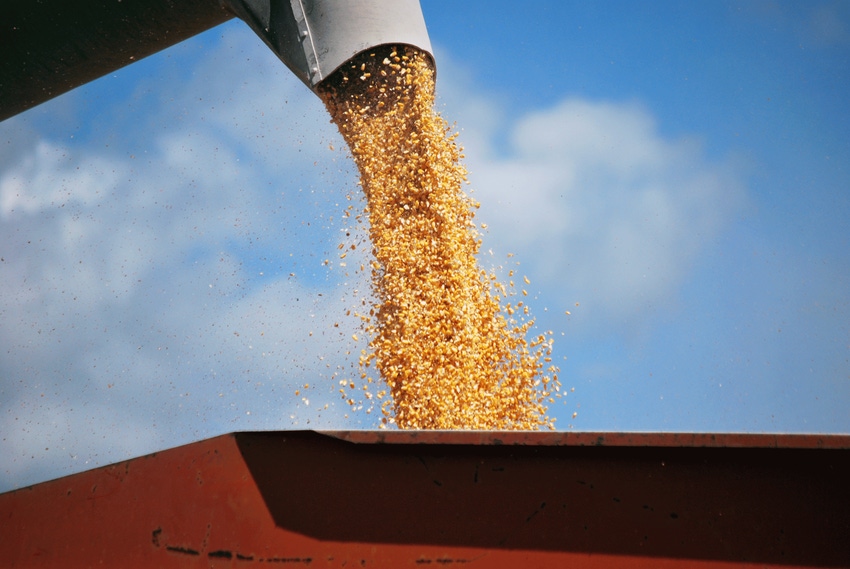
As the combines worked through the last 20 acres of his corn, Jody Childs was on the phone trying to secure just two more semi-trailers to haul the corn off his farm and finish out his harvest, topping off a corn season with good yields but one tough to get to the buying points.
“It’s been this way all harvest: either you can’t get trucks lined up when you need them or you had a chance to get them but not have a load for them and you don’t want a bunch of truckers headed your way when you don’t have a load for them … It’s been a nightmare,” Childs said, with a wry chuckle.
As he drove around the cornfield in his truck mid-morning Sept. 16, his phone rang. After another quick conversation and a “thank you,” it was just one more call that didn’t produce a truck, and the buying points were closing at noon that day, a Friday. The clock was ticking.
One trucker who had recently hauled a load for him had just sold his trailer and was about to head to Kansas to buy another trailer, but that didn’t do Childs any good that day.

Jody and Jennifer Childs live near Hartford, Ala., and have two children: Connor, 8, and Bella, 6.
Jody and Jennifer Childs live near Hartford, Ala., and have two children: Connor, 8, and Bella, 6.During the season, there were tales of semi-trailer trucks backed up 40 deep waiting to get unloaded at local buying points. One story had a buying point manager coming out with a piece of chalk and marketing a line behind a truck, his way of indicating any truck behind that line wouldn’t be unloaded there that day.
Wiregrass farmer
Childs farms in the southeast part of Alabama known as the Wiregrass, an agriculturally diversified region. Childs’ operation is typical there. He manages about 1,200 acres of peanuts, cotton and corn and runs about 150 mama cows with one other full-time employee.
Harvest is always hectic for farmers like Childs, threading the needle between getting corn pulled, peanuts dug and picked and cotton defoliated and baled. Childs admitted, with another laugh, that the frenzy of this time of year comes with its own special rush, one he doesn’t mind and, in a lot of ways, enjoys.
“The logistics of the corn is the challenging part; at least it has been for the last few years, but I tell you, if your head can’t stand drought, mechanical problems or logistical problems, and you do this for a living, you are in the wrong business because when it’s coming, it’s all coming,” said Childs, who graduated Troy State 20 years ago with a general business degree.
Childs has a few small grain bins to use on his farm. But in a panic early in the corn harvest, he bought a bagging system to store his corn short-term just in case things with the trucks got worse. Things didn’t get critical enough to use the bagging system this year, but he is keeping the system just in case for next year.
Transportation competition
Corn in Alabama is forecast at 38.4 million bushels, up 7 percent from 2015, according to USDA’s September forecast. Corn growers in Florida, Georgia and Alabama harvested a big crop this year, and they typically hit the combines at around the same time, starting early in August and running through the first of September as corn harvest moves north through the country. Competition for semi-trailers to haul Deep South corn can be tough at certain points during harvest, but it was especially tough for Childs this year, and he said he wasn’t the only one in his region scrambling for transportation.
Childs’ corn yields were excellent this year, hitting close to a 230-bushel average on irrigated and a 170-bushel average on dryland. Wiregrass farmers don’t have near the amount of irrigated acres as their counterparts in Georgia just across the Chattahoochee River.
But irrigation installation is on the rise in the region. Alabama passed legislation a few years ago to help Alabama farmers install irrigation through a cost-share program. Childs took advantage of the offer, as did other farmers in the region. It’s having a positive impact on production and yields, he said.
His area of Alabama used to be heavy in textile manufacturing but a trade deal between the countries of North America two decades ago, ‘dried that up pretty fast,” he said. Agriculture remains the backbone of the economy, and the Wayne Farms poultry plant nearby has reinvigorated corn production in the region. Childs corn will go to chicken feed. And for now, the basis farmers are getting for their local corn is pretty good.
Family matters
Another event two decades ago changed things closer to home for Childs: his father, Joel Childs, passed away after a short battle with lung cancer. That’s when Childs, 22 at the time, picked up the family operation and became a full-time farmer. He is married to Jennifer and they have Connor, 8, and Bella, 6. They live on the land his family homesteaded five generations ago and near the same place where his parents, Joel and Judy, raised him, his brother, Chris, who has passed, and sister, Cheri, who still lives nearby.
Back at his cornfield that day, Childs had pressing matters other than trucks: Jennifer told him he needed to stop work early that day. Some friends of theirs who run a camp for autistic children are acquainted with country music singer Zac Brown, who also established and runs a camp for kids. The friends had gotten the Childs family hotel accommodations, tickets and backstage passes to the Zac Brown Band concert in Birmingham that evening. The clock was ticking on getting out of the field and to the show.
As noon came and went along with his hopes of loading more trucks with his corn, Childs was asked what he planned to do about getting the last of his corn crop put to bed. “I don’t have it figured out right now, but we’ll get it figured out -- maybe.”

Corn growers in Florida, Georgia and Alabama harvested a big crop this year, and they typically hit the combines around the same time. Every year, competition for semi-trailers to haul Deep South corn can be tough at certain points during harvest, but it was especially tough for Alabama farmer Jody Childs this year.
Corn growers in Florida, Georgia and Alabama harvested a big crop this year, and they typically hit the combines around the same time. Every year, competition for semi-trailers to haul Deep South corn can be tough at certain points during harvest, but it was especially tough for Alabama farmer Jody Childs this year.About the Author(s)
You May Also Like






